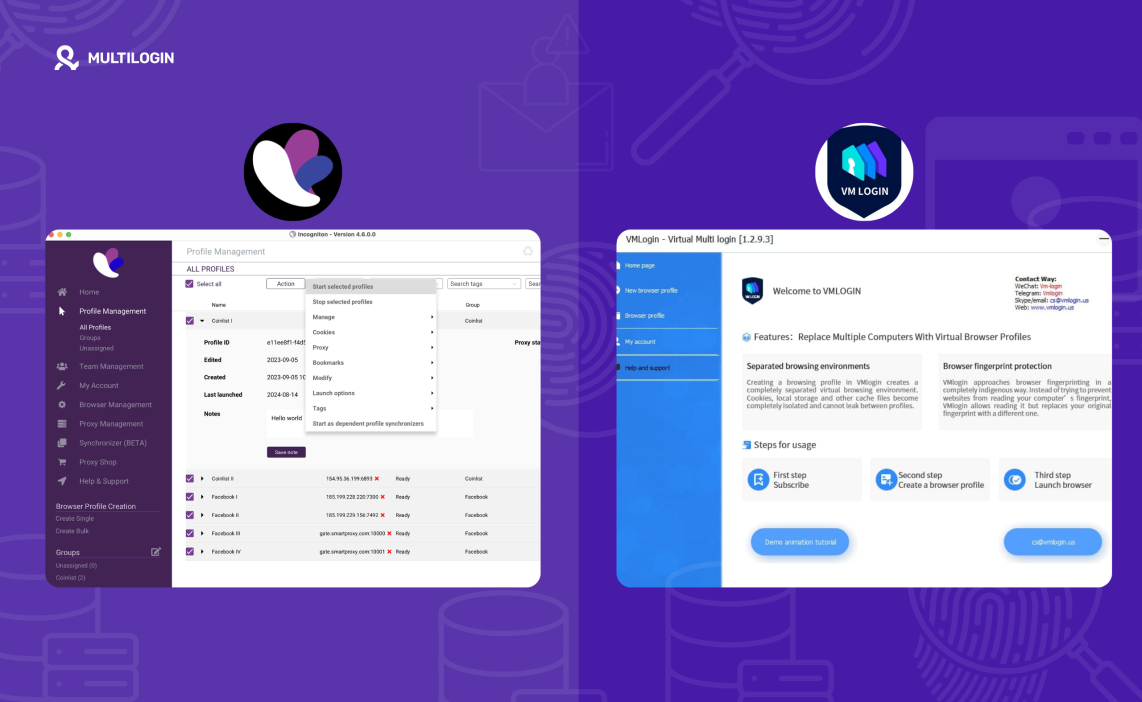If you’re managing multiple online accounts, whether for affiliate marketing, e-commerce, dropshipping, or social media automation, you already know the challenges. Platforms like Facebook, Amazon, and even ChatGPT are equipped with sophisticated detection systems that flag accounts with matching fingerprints or IP addresses.
This is where antidetect browsers like Incogniton and VMLogin come in. They allow you to create multiple isolated browser profiles, each with its own unique fingerprint, making them appear as separate devices to websites.
In this guide, we’ll compare Incogniton vs VMLogin in-depth — looking at features, usability, pricing, automation capabilities, and stealth performance — and answer common questions about these tools, including how they compare to Multilogin.
Quick Comparison Table
Feature | Incogniton | VMLogin |
Core Engine | Chromium-based | Chromium-based |
OS Support | Windows, macOS | Windows |
Pricing | Free tier + paid plans | Paid only |
Profile Storage | Local + Cloud | Local + Cloud |
Proxy Support | HTTP, HTTPS, SOCKS5 | HTTP, HTTPS, SOCKS5 |
Automation Support | API + Selenium/Puppeteer | API + Selenium/Puppeteer |
Best For | Beginners & small teams | Agencies & advanced operators |
Incogniton Overview
Incogniton is designed with simplicity and accessibility in mind. It uses a Chromium engine for broad website compatibility and offers a free plan — making it an attractive entry point for beginners or small-scale operators.
Key Features:
- Profile creation with unique fingerprints
- Local and cloud profile storage
- Team sharing and role-based permissions
- Proxy integration for each profile
- API support for automation
Pros:
- Free tier available
- Clean and easy-to-use interface
- Quick onboarding for new users
Cons:
- Limited advanced fingerprint customization compared to premium tools
- Fewer automation integrations than competitors like Multilogin
VMLogin Overview
VMLogin positions itself as a professional-grade antidetect browser for teams managing hundreds or thousands of accounts. Like Incogniton, it’s Chromium-based, but it leans toward advanced customization and high-volume management.
Key Features:
- Full fingerprint customization (hardware, OS, browser settings)
- Local and cloud profile sync
- Proxy assignment per profile
- Bulk profile creation and management
- Automation via API, Selenium, and Puppeteer
Pros:
- Highly customizable profiles
- Stable under heavy workloads
- Better suited for large-scale operations
Cons:
- Paid-only, no free plan
- Windows-only (no native macOS support)
Fingerprint Spoofing & Privacy
Incogniton: Strong baseline fingerprint masking, easy to set up. Ideal for users who want quick protection without deep manual configuration.
VMLogin: Offers more granular control over fingerprint variables, letting you fine-tune every aspect for maximum stealth.
Winner: VMLogin for advanced users, Incogniton for beginners.
Profile Management
Both tools let you create, store, and manage isolated profiles that can’t be linked to each other.
Incogniton: Allows team sharing with simple permissions, but less bulk management functionality.
VMLogin: Designed for bulk operations, with profile cloning, mass edits, and better organization tools.
Winner: VMLogin for large-scale teams, Incogniton for smaller setups.
Proxy Integration
Incogniton: Supports HTTP, HTTPS, and SOCKS5. Setup is straightforward with a clean UI.
VMLogin: Same proxy compatibility but with bulk proxy import and rotation for large-scale campaigns.
Winner: VMLogin for high-volume proxy management.
Automation Support
Automation is crucial for scaling operations.
Incogniton: API access and integration with Selenium or Puppeteer make it automation-ready, but automation stability is stronger on more enterprise-focused platforms.
VMLogin: Built for automation-heavy workflows, with robust API support and better handling of automated tasks without detection triggers.
Winner: VMLogin for automation reliability.
Performance & Speed
Incogniton: Lightweight and fast on profile launch; best for moderate profile counts.
VMLogin: Handles large numbers of concurrent sessions without major slowdowns, though resource usage is higher.
Winner: VMLogin for scale, Incogniton for efficiency on smaller workloads.
Pricing
Incogniton:
- Free tier with limited profiles
- Paid tiers starting at a low monthly cost
VMLogin:
- Paid-only plans, priced for professional use
- No permanent free tier
Winner: Incogniton for budget-friendliness, VMLogin for feature depth.
Incogniton vs VMLogin vs Multilogin
While Incogniton is easy to start with and VMLogin is great for customization and bulk operations, many professionals eventually choose Multilogin for its combination of scale, stability, and stealth.
Why Multilogin Often Wins:
- Enterprise-grade fingerprint automation without performance penalties
- Encrypted cloud storage that syncs thousands of profiles instantly
- Built-in residential proxy support for improved stealth
- Advanced team permissions & activity logging
- Cross-platform — works on Windows, macOS, and Linux
If Incogniton is the starter car and VMLogin is the sports car, Multilogin is the bulletproof SUV — built for both speed and survival.
Ready to Try the Best? No Risk, Big Upside
Why settle for half-measures or take risks with your privacy and accounts?
Frequently Asked Questions About Incogniton vs VMLogin
Multilogin offers more advanced fingerprint automation, enterprise-level collaboration tools, and built-in residential proxy support, making it ideal for large-scale professional use. Incogniton is easier for beginners but less powerful for high-volume automation and scaling.
Top alternatives include Multilogin for enterprise use, Kameleo for mobile/desktop spoofing, GoLogin for affordability, and Incogniton for beginners or budget-conscious users.
The “best” depends on your needs:
- Multilogin — Best for professional scaling and team collaboration
- VMLogin — Best for bulk profile management and customization
- Incogniton — Best for beginners and small teams starting out
Both are powerful, but Multilogin supports more operating systems, offers better fingerprint automation, and includes enterprise team features that VMLogin lacks. VMLogin focuses more on granular fingerprint customization for Windows users. Learn more in our detailed comparison.
Conclusion
The Incogniton vs VMLogin comparison highlights the trade-off between simplicity and power in antidetect browsers. Incogniton makes multi-account management accessible but lacks advanced features. VMLogin provides powerful isolation but excludes non-technical users with complexity and costs.
Multilogin transcends this trade-off by delivering enterprise-grade features through a user-friendly interface at just €5.85/month. Including residential proxies eliminates hidden costs while proven protection ensures account safety across all platforms.
Whether you’re managing e-commerce stores, growing social media accounts, or scaling affiliate campaigns, Multilogin provides everything needed for success without breaking the budget.



